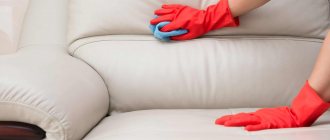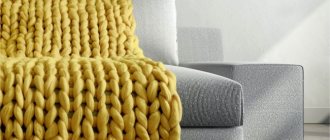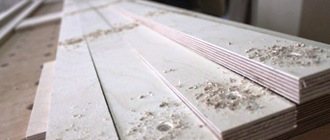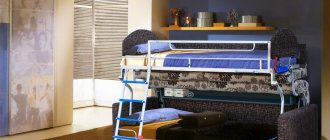6049
Beautiful, elegant leather furniture can decorate and add solidity to any interior. It perfectly complements the office, living room, and leather chairs perfectly complement the interior of the kitchen. Cleaning leather furniture is a mandatory procedure if you decide to purchase such furniture. In order not to damage the structure of the material during cleaning, it is worth knowing the basic rules for working with leather, choosing the right products, and also taking into account possible factors of damage.
A little about the leather sofa
- To know what can and cannot be done with any thing, you need to have at least some idea of what it is made of.
- If previously cattle leather was used for furniture, today you can already buy a sofa covered with the skin of an exotic animal.
- The highest quality coating is considered to be the top layer of leather. It has high elasticity, the texture of the skin is clearly visible. Furniture with such a coating is an expensive pleasure and is of an exclusive nature.
- The middle and lower layers of the skin are less elastic and have a blurred pattern.
- Genuine leather has black, brown and beige colors. Therefore, you can immediately determine whether your sofa is “painted” or natural and, accordingly, take this into account when cleaning it.
Currently, painting with natural dyes predominates, which makes furniture environmentally friendly. The range of colors used for painting is quite diverse.
To this day, you can still find furniture with leather coverings dyed with aniline dyes. You should know that this type of dye has a negative impact on your health.
Removing stains
You might think that stains form on the surface of the sofa only if you have children in the family, however, this is not the case. Agree that many people like to lie on the couch before watching their favorite TV series with their favorite food and drinks. This way you can accidentally stain the furniture. What to do? Do not panic. The main thing is not to let the situation get worse and start fighting pollution as early as possible.
Important! Do not use brushes made of hard materials, as well as products that contain alkalis, acids and chlorine.
Now about the products that are suitable:
- How to clean a leather sofa at home? If you spill juice, you can get rid of the stain using ammonia. Pour a little product, leave for a couple of hours, and then use clean warm water.
- Blood stains are quite difficult to remove, but not impossible. To do this, soak in water and soap with laundry soap. After three hours, rinse with cold water. The difficulty in dealing with blood is that it is rarely wiped off the first time. This is why you need to repeat the steps a couple of times. Laundry soap is an excellent product if you are wondering how to clean a white leather sofa.
- The easiest way is to remove grease from the surface of furniture. To do this, blot the stain with a napkin, and then cover it with salt, flour or potato starch. After half an hour, not a trace of fat will remain.
- How to clean a milky sofa if it has coffee stains. If you accidentally spill coffee on the sofa, fill it with dishwashing detergent and leave for two hours. After time has passed, clean the stain with soapy water.
- How to clean dirt from a leather sofa? To remove spilled wine, sprinkle salt on the stain. After an hour, scrub the area with a brush. Remove any remaining residue and treat the contaminated area with alcohol.
- Alcohol will also help remove marks from felt-tip pens and ballpoint pens. As an option, you can use vodka and acetone, but these are already radical measures that should be resorted to only in the worst case scenario.
Basic rules for caring for a leather sofa
Before you begin cleaning your leather sofa, you should read the contents of the accompanying documentation that was given to you upon purchase. It is important to know what detergents are recommended by the sofa manufacturer to clean it from dirt. The same products cannot be used for patent leather and aniline leather.
If you are not sure of the positive results of the detergent, do a test cleaning in an area that is not visible to prying eyes. It is possible that you will need to test more than one product before you find the right one that is suitable for your sofa.
Don't rush to judge the effect of the detergent before you start cleaning the entire sofa. Wait until the tested area of leather is completely dry and, only after making sure that there are no traces of dirty stains left in the form of a change in the original color of the leather, proceed to cleaning the rest of the sofa.
First of all, you should clean the sofa of large debris. It is best to use a regular vacuum cleaner for this, but you should vacuum carefully so as not to damage the leather covering of the sofa with the nozzle. After this, you can begin wet cleaning the sofa covering.
After removing large debris, you need to begin removing various dirty spots. This will probably be the hardest part of your job, but it needs to be done first because the stains contain a higher concentration of dirt than the rest of the sofa cover.
Do not use cleaning products not intended for leather products. While using these products may remove stains, you will also remove the protective top layer of natural oils. The result of such cleaning will very soon appear in the form of cracks.
Everyone knows that leather is a porous material in its structure. And this feature, after some time, begins to make itself felt. Dirt gets clogged into the pores of the skin, which is not so easy to “pick out” with an ordinary sponge. And here any brush will come to your aid, even a toothbrush, but with soft bristles, which will reach dirt in the most inaccessible places, including in the pores.
Do not use too much force when removing stains. Your diligence will only help the dirt rub deeper into the pores of the skin.
If you accidentally spill any liquid on the sofa, immediately remove it with a soft material that absorbs moisture well. This should be done exclusively with blotting movements. Rubbing movements are unacceptable, as this will contribute to rubbing this liquid (tea, coffee, etc.) into the pores of the skin and will only aggravate the situation. The result will appear, if not instantly, then after some time - for sure. A stain on the sofa is guaranteed.
But if you “spill” natural milk on the sofa, it will even be good for it, because the oil it contains will soften its leather covering. And you don’t need to buy special products to moisturize the coating, the composition of which is not always free of chemical components. It’s probably not worth explaining to you what is healthier, natural or artificial. Of course, you shouldn’t use butter in its pure form - the effect will be the opposite.
After cleaning the leather sofa and letting it dry completely, do not forget to apply a layer of conditioner - a wax-based moisturizer - to the leather. This should be done regularly, but not often - once every six months will be enough.
If your efforts to clean the soiled areas of the sofa do not give the desired result, do not be discouraged - contact a specialist.
Rules for working with leather
Leather sofas and armchairs not only have an attractive appearance, but have many other advantages. They are durable, wear-resistant, and resistant to moisture. A pleasant aroma of leather gently fills the room where the products are installed. Modern manufacturers in workshops use special impregnations that do not allow furniture to quickly fail. Depending on the raw materials from which the furniture is made, the selection of cleaning products and the choice of methods for cleaning the products will be important.
By referring to the instructions that come with the furniture, you can find out about the composition of the material, as well as the type of impregnation located on the surface. This information will help you avoid damaging the coating in the future and perform cleaning correctly at home. Before cleaning the surface, it is important to know the rules for working with leather. These also include special operating conditions for models and daily care of furniture. If you do light cleaning daily, it will take less time for general treatment:
- When cleaning furniture at home, you should not heavily rub the surface of sofas and armchairs every day. Such care is excessive and will lead to rubbing of the coating, which will cause unsightly light spots on the surface;
- Careful cleaning of seams. Deep hollows often form at the joints and seams of the material. Dust noticeably settles in them and dirt accumulates. It would be optimal to vacuum these areas once a week using a narrow crevice nozzle;
- Wiping. It is recommended to wipe the surface of the skin with a damp cloth made of soft material. After this, it is advisable to wipe the surface dry;
- The use of special means and folk methods. There are cleaning compositions developed for the care of leather products - they are presented in several types and are intended for different stages of processing. It is also recommended to use orange peel to mask scuff marks. This should be done only after information about real leather on the furniture has been obtained.
Synthetic materials, such as leatherette, must be cleaned using other means. They are more gentle than skin formulations.
Cleaning a light sofa
The light leather of the sofa is an excellent object for your child to draw with a felt-tip pen or ballpoint pen, left “for a minute.” The issue of removing a child’s “art” is not so difficult if you start solving it in time. To do this, you will need alcohol or acetone (acetone is an extreme measure that requires some skill on your part). A napkin moistened with a solution of these products will easily remove traces of a ballpoint pen or felt-tip pen.
Traces of spilled coffee or tea on a light-colored sofa can be perfectly removed by a solution of natural soap that does not contain sodium lauryl sulfate. If soap does not do the job, you can use a weak solution of vinegar.
An important advantage of a light sofa over a dark one is the ability to use products without fear of noticeably damaging its color.
Leather can be cleaned using regular dishwashing detergent. Use a sponge soaked in this product to wipe the surface of leather furniture. After this, its remains are washed off with a damp cloth.
Regular cleaning of leather furniture
Leather is a special material and requires careful care. Therefore, in order for the furniture to remain in good condition for a long time and be pleasant both to look and to the touch, it is recommended to regularly thoroughly clean the surface with a damp cloth (clean or soaked in soapy water). After which you need to wipe everything dry.
Following simple rules will allow you to preserve the original appearance of a leather sofa and extend its service life.
In addition, it is necessary to remove debris from the surface of the sofa as often as possible, especially in folds and joints, since the accumulation of dirt can lead to the appearance of fungus. The most convenient way to do this is with a vacuum cleaner. It would be a good idea to lubricate the surface with a glycerin-based leather furniture cleaner once or twice a month to prevent the leather from drying out.
Avoid exposing your skin to direct sunlight, as ultraviolet radiation causes paint to fade.
Cleaning a dark sofa
The unfortunate thing about a dark leather sofa is how delicate it is to clean. You should be careful when using alcohol to clean leather, because the quality of its painting may not be up to par, and you may end up with an excellent “camouflage” version of the sofa. It is doubtful that this will make you happy. Therefore, before using alcohol to clean leather, you should try to wipe it in a place where, in case of a negative result, it would not be noticeable.
A little about hygiene
Of course, dirt is a matter of hygiene. But we must not forget about such things as fungus or mold. Its presence in the folds of a leather sofa poses a certain threat, both to the “health” of the sofa and to you. To disinfect an area infected with fungus, you can use a weak vinegar solution. But you should clean the infected area quickly so that the solution does not have time to absorb into the leather of the sofa.
Scuffs or scratches cause no less concern for the owner of a leather sofa.
But it’s not all bad here either. There is a special water-soluble polymer, it is also called liquid skin. It has seven colors, which allows you to get almost any shade. Apply it to the damaged area in a thin layer. To ensure that the restored area acquires the texture of leather, immediately after applying the polymer, press it with a dry sponge. If the restoration did not work out the first time, do this procedure again.
Leather abrasions can be eliminated using neutral shoe polish. As a result, you will again get a brand new leather sofa, having spent only on a jar of cream or a spray of polymer.
Side effects and defects
A new leather sofa can become unusable over time if torn areas quickly appear on its surface. To avoid further damage to the surface, be sure to patch the hole before cleaning the furniture. In such a case, you should contact a salon or repair shop.
Below are some recommendations for caring for furniture that has surface defects:
- Never use baby wipes to remove stains of various types. The use of such products will damage the coating, but do not despair - it can be restored. For this purpose, special leather paint is sold in stores. It is diluted according to the instructions and carefully masks the defect;
- If after each cleaning it is discovered that the skin has lost its elasticity, this can be corrected with a folk remedy: add 2 parts linseed oil to 1 part vinegar. The resulting mixture should be rubbed into the skin in a circular motion, then polished with a dry cloth.
If, even after cleaning at home, the furniture has lost its attractiveness, this is a reason to turn to professional dry cleaning. It is better to do it twice a year. Craftsmen use special impregnations that prevent the leather from cracking and drying out. It retains its external characteristics for a long time.
When using upholstered leather furniture, do not allow it to come into frequent contact with animals and fleecy rugs and blankets. Such textiles clog the pores of the skin structure, creating particles of debris at the seams, as a result of which they are difficult to remove from the surface. Weekly wet cleaning will make general cleaning of leather furniture easier.











